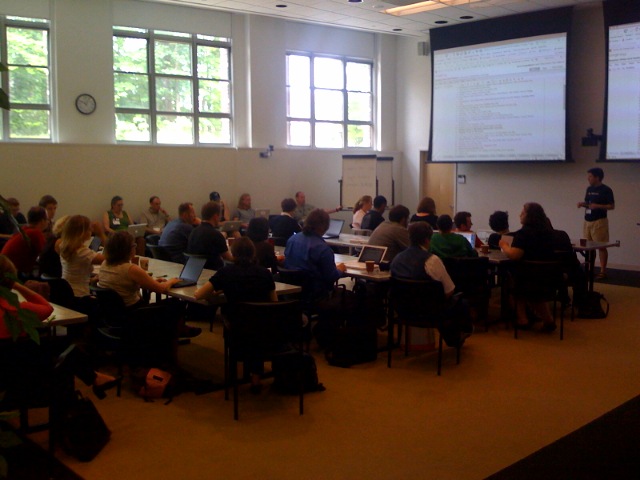“Less talk, more grok.” That was one of our early mottos at THATCamp, The Humanities and Technology Camp, which started at the Roy Rosenzweig Center for History and New Media at George Mason University in 2008. It was a riff on “Less talk, more rock,” the motto of WAAF, the hard rock station in Worcester, Massachusetts.
And THATCamp did just that: it widely disseminated an understanding of digital media and technology, provided guidance on the ways to apply that tech toward humanistic ends like writing, reading, history, literature, religion, philosophy, libraries, archives, and museums, and provided space and time to dream of new technology that could serve humans and the humanities, to thousands of people in hundreds of camps as the movement spread. (I would semi-joke at the beginning of each THATCamp that it wasn’t an event but a “movement, like the Olympics.”) Not such a bad feat for a modestly funded, decentralized, peer-to-peer initiative.

THATCamp as an organization has decided to wind down this week after a dozen successful years, and they have asked for reflections. My reflection is that THATCamp was, critically, much more than THAT. Yes, there was a lot of technology, and a lot of humanities. But looking back on its genesis and flourishing, I think there were other ingredients that were just as important. In short, THATCamp was animated by a widespread desire to do academic things in a way that wasn’t very academic.
As the cheeky motto implied, THATCamp pushed back against the normal academic conference modes of panels and lectures, of “let me tell you how smart I am” pontificating, of questions that are actually overlong statements. Instead, it tried to create a warmer, helpful environment of humble, accessible peer-to-peer teaching and learning. There was no preaching allowed, no emphasis on your own research or projects.
THATCamp was non-hierarchical. Before the first THATCamp, I had never attended a conference—nor have I been to one since my last THATCamp, alas—that included tenured and non-tenured and non-tenure-track faculty, graduate and undergraduate students, librarians and archivists and museum professionals, software developers and technologists of all kinds, writers and journalists, and even curious people from well beyond academia and the cultural heritage sector—and that truly placed them at the same level when the entered the door. Breakout sessions always included a wide variety of participants, each with something to teach someone else, because after all, who knows everything.
Finally, as virtually everyone who has written a retrospective has emphasized, THATCamp was fun. By tossing off the seriousness, the self-seriousness, of standard academic behavior, it freed participants to experiment and even feel a bit dumb as they struggled to learn something new. That, in turn, led to a feeling of invigoration, not enervation. The carefree attitude was key.
Was THATCamp perfect, free of issues? Of course not. Were we naive about the potential of technology and blind to its problems? You bet, especially as social media and big tech expanded in the 2010s. Was it inevitable that digital humanities would revert to the academic mean, to criticism and debates and hierarchical structures? I suppose so.
Nevertheless, something was there, is there: THATCamp was unapologetically engaging and friendly. Perhaps unsurprisingly, I met and am still friends with many people who attended the early THATCamps. I look at photos from over a decade ago, and I see people that to this day I trust for advice and good humor. I see people collaborating to build things together without much ego.

Thankfully, more than a bit of the THATCamp spirit lingers. THATCampers (including many in the early THATCamp photo above) went on to collaboratively build great things in libraries and academic departments, to start small technology companies that helped others rather than cashing in, to write books about topics like generosity, to push museums to release their collections digitally to the public. All that and more.
By cosmic synchronicity, WAAF also went off the air this week. The final song they played was “Black Sabbath,” as the station switched at midnight to a contemporary Christian format. THATCamp was too nice to be that metal, but it can share in the final on-air words from WAAF’s DJ: “Well, we were all part of something special.”



